Congratulations to IIMAIA Instructor Diana Rathborne (Minnesota Kali Group)on her promotion to Full Instructor under Ajarn Chai Sirisute in the Thai Boxing Association.
Instructor Information
Meet Your Instructors – Part 1
Meet Your Instructors Part One
(A Work in Progress)
To find out how to to contact one of instructors please click on our Instructor directory. (Instructors Worldwide | Instructors USA)
Ultimate Fighter – Greg Nelson
Ultimate Fighter – Greg Nelson
written by Andy Grahn
My state of Minnesota is one of the coldest places in America, with freezing temperatures regularly dropping to below zero during the winter. Many people say that the harsh conditions of Minnesota winters seem to add an extra level of motivational difficulty to training by building character. Out of these rough winters have come many great athletes and sports figures such as Greg Nelson.
At an early age, Greg was involved in all kinds of athletics, among them swimming, basketball, t-ball, you name it. It was during his high school years that he found two sports that would ultimately play a huge role in his future: gymnastics and wrestling. Each sport was built on strong team discipline and coaching methods, with twice a day practices being common in gymnastics. His gymnastics team took 3rd, 1st and 2nd place in the state tournament during sophomore, junior and senior years respectively. Greg took 2nd place in the Junior National Freestyle Wrestling Tournament in his weight division.
When it came time for college, Greg was eligible for scholarships in both sports, so he decided to flip a coin, and it came up “wrestling.” Greg joined the University of Minnesota’s wrestling team. Now, for those who don’t know wrestling, in the upper Midwest it’s always been a huge sport. Many of America’s top wrestlers are recruited to go to colleges in Minnesota, Iowa, Wisconsin and Michigan. Greg competed at a national level and further developed his athletic abilities for 4 years while working on a degree in International Relations/Interstate Diplomacy.
While Greg was working at “My Pie Pizza,” an incident occurred during which he met Steve Kaye. After watching Steve perform some swashbuckling techniques in the kitchen, he approached him and asked where he learned his moves. Steve was reluctant to tell Greg at first, but eventually relented and brought him to Guro/Khru Rick Faye’s garage. From that point on, he was hooked and began his training in Kali, Jun Fan and Muay Thai.
During this time, Greg got a job at the local Target department store, where he began a career as a Loss Prevention Officer. At Target, Greg found many opportunities to experiment with his martial arts skills, and he learned many practical lessons like “Sometimes when you kick someone in the leg, they just won’t go down.” Working in Loss Prevention gave Greg many chances to learn “real world” applications of force.
In 1992, Greg started his own school: The Minnesota Martial Arts Academy. The Academy is based on a Latin phrase “Opera Non Verba,” which roughly means “Deeds Not Words.” His vision was to develop a core group of fighters committed to combative integrity in martial arts. The idea was to take martial arts theory and put it to the test, finding out what works and what doesn’t, and gaining knowledge from the experience because for many people, experience is the best teacher.
Greg kept a rigorous schedule working during the day, from 6:00 A.M. to 2:00 P.M., then at the gym for three hours, five days a week, plus four hours on Saturday. Team training started every day at 3:00 P.M. and lasted until 6:00 P.M. when evening classes started. Class ran from 6:00 – 9:00 P.M. His classes focused on what he had personally discovered that worked in the ring and on the street. This mentality was all about hardcore physical fitness. Greg hopes that people will develop physically, mentally and emotionally by forging through the deep barriers of fatigue.
Greg’s philosophy about martial arts is based on his personal experiences. He believes we must challenge our assumptions, and that we can appropriate any techniques we have learned. Putting your skills to the test will only help develop your martial arts ability, and hence develop you mentally and emotionally. He believes in competition – not necessarily for the sake of domination – but for your own personal development.
From Thai Boxing Association, U.S.A. Magazine
Spotlight: Greg Nelson
Spotlight on IIMAIA Instructor
July 2007
Greg Nelson
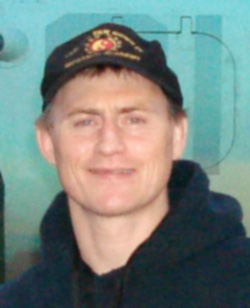
Nelson, Greg
Head Instructor/Owner
Greg Nelson has his roots in athletic training and competition. Nelson is a former University of Minnesota Wrestling Team member and an All-American high school gymnast. Since starting his martial arts training in 1983, Mr. Nelson has earned Full Instructor Credentials in Jun Fan Martial Arts/Jeet Kune Do Concepts, the Filipino Martial Arts, and a Level III Instructor in Maphilindo Silat under Guru Dan Inosanto. Mr. Nelson is also a Full Instructor in Muay Thai under Ajarn Chai Sirisute of the Thai Boxing Association of the USA. A grappler at heart, Nelson earned the level of Advanced Student in Shoot Wrestling under Sensei Yurinaga Nakamura, and a certified Full Instructor in Combat Submission Wrestling under Erik Paulson. In 2002 Greg was awarded his Black Belt in Brazilian Jiu-Jitsu under professor Pedro Sauer. Greg has taught tactical training to numerous Federal and local law enforcement agencies and military units, including the FBI, the US Army National Guard, and the Federal Air Marshalls. In addition, Greg is a husband and father of two young children. Greg is also a 2 time cancer survivor after beating first non-nodgkins lymphoma and secondly beating a rare form of nerve cancer called neurolymphomatosis.
On a competitive level, Nelson has put his skills to the test. After graduating from college in 1989, Nelson started competing again in 1993. Nelson fought Muay Thai in the US and in Canada, Amateur Shoot Wrestling(MMA), won a Gold Medal in Brazilian Jiu-Jitsu in the 1999 Pan-Ams, a Silver Medal in thee 2000 Pan-Ams, and most recently three golds in 2001 Grappling Games in LA.
As a coach, Nelson has developed numerous champions in Muay Thai, with several fighters holding title belts from the UFC, CMTF, USMTA, IKF, ISKA, WKA, NAGA, and a Bronze Medal in the 1996 Muay Thai World Championships. In submission grappling and mixed martial arts competitions Academy fighters have victories and titles in the the Ultimate Fighting Championships, Pride Bushido, BodogFIGHT, Shooto, King Of The Cage, Super Brawl, Hook-N-Shoot, All-Osaka Shoot Boxing Championships, San Shou Championships in Bejing China, IFC, Extreme Challenge, Danger Zone, WEF, WEC, and many more. Fighters such as UFC Lightweight Champion Sean Sherk, IKF & WKA Pro-Muay Thai Champion Nat McIntyre, CMTF/USMTA Champion James Cook, Former UFC Middleweight Champion Dave Menne, BodogFIGHT Welterwight Champion Nick “The Goat” Thompson, Adam Clary, John Renken, Tom Schmitz, and Brad Kohler have gained the mass of their Muay Thai and MMA training under the tutelage of Greg Nelson.
courtesy of Minnesota Martial Arts Academy
http://www.mmaacombatzone.com/
Nelson, Greg
Head Instructor/Owner
Rank:Instructor
Email:GregNelson@MMAACombatZone.com
Phone:763-560-5696
Leo M. Giron
Leovigildo “Leo” Migel Giron was born in Bayambang, a little barrio in the province of Pangasinan, Philippines, on August 20, 1911. He began his training in the Filipino arts because of the neighborhood children and bullies who tried to take advantage of him and others. Giron soon learned, however, that if he stood up to them and made one of them cry, the rest would run away and leave him alone.
In 1920, young Giron started his education in arnis escrima. Benito Junio was his first teacher, and was from a little barrio of Inerangan, town of Bayombang, province of Pangasinan, Philippines. Benito Junio was famous for his styles of larga mano (long hand weapon fighting) and fondo fuerte (fighting in a solid position).
From 1921 to 1926, Giron continued his training with Fructuso Junio, uncle to Bentio Junio. Fructuso Junio was from the barrio of Telbang, town of Bayombang, province of Pangasinan, Philippines. Fructuso Junio was well known for his macabebe or the use of two weapons fighting. Fructuso was the first to share with Giron the importance of distinguishing between the old style (cada-anan) and new style (cabaroan) of the Filipino fighting arts.
On October 29, 1926, at the age of 15, and with only $3.75 in his pocket, Giron set sail on the USS President Lincoln for America. By the time the ship arrived in California, Giron had only 25 cents left in his pocket. One of his town mates brought Giron to the Star Hotel on El Dorado Street in Stockton, California, where the rooms were 50 cents a night and $3.50 per week. Luckily for Giron, a farmer from Terminus Island needed a few boys to harvest celery. Although the pay was normally 35 cents an hour, because of Giron’s age, he only received 17.5 cents an hour. This way of life was typical for most Filipinos who came to America.
![]()
Young Giron in Stockton, California in the 1930’s
In 1920, Giron met a man by the name of Flaviano Verguara. Verguara was from the town of Santa Cruz in Ilocos Sur Luzon, Philippines. Vergara was the top student of Dalmacio Bergonia who defeated the great champion, Santiago Toledo. Vergara and Giron started their training in the deep in the prune orchards of Meridian California, from 1929 to 1932. Vergara and Giron met again directly after the outbreak of World War II. Their lives would cross for the last time in October 1942, when Giron was shipped out to Fort Ord, California. Every spare minute, Vergara and Giron would train, until Giron was shipped out in January, 1943. Vergara was a master in the Bergonia style and very proficient in estilo elastico (rubber band style). Giron had said that Vergara had superhuman abilities. Vergara influenced Giron the most out of all his teachers with his understanding of the relationships between the cada-anan (old style) and cabaroan (new style) of arnis escrima. Vergara was also the teacher who gave Giron the Abanico del Maestro (The Fan of the Master).
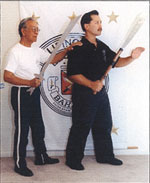
GME Leo M. Giron and GM Tony Somera with the Abanico del Maestro
During the outbreak of World War II, Giron was assigned to General Douglas MacArthur’s group of secret commandos. During his secret missions in the Philippines, Giron was assigned to a sergeant from the Philippine army by the name of Benigno Ramos. Ramos was from Kongkong, a town of Bayonbang, province of Nueva Vizcaya. Ramos was also an expert in arnis escrima, and fine-tuned Giron’s combat skills during combat encounters. Giron and Ramos trained and fought in the jungles of the Philippines for over a year under the most extreme conditions of juingle warfare.
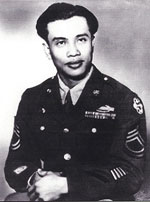
Sergeant Leo M. Giron, United States Army, 978th Signal, 1945
From 1956 to 1961 Giron trained with another master escrimador. His name was Julian Bundoc from the barrio of Carangay, town of Bayonbang, province of Pangasinan, Luzon, Philippines. Julian Bundoc was cousin to Benito Junio. Julian Bundoc and Giron played more of the combative larga mano and worked on conditioning the body. Julian Bundoc was also a master of hilot, or massage.
During his duty during world War II, Grand Master Giron was awarded a Bronze Star medal and many more accommodations.
In 1968, Leo Giron opened his first licensed Bahala Na Club in Tracy , California where Giron and his wife, Alberta, resided. Giron was motivated after he heard on the news that a man in Chicago killed eight student nurses, and some of the nurses were Filipina. In 1970, Leo and wife, Alberta moved to Stockton, and so did Giron’s Bahala Na Club.

Leo Giron teaching at his first club in Tracy, California, 1968
In early 1970, during a wedding of a daughter of a local Filipino family, Mrs. Mary Inosanto (Daniel Inosanto’s mother) approached Leo Giron to inquire about Giron’s teaching escrima. Giron, being a quiet and humble man, listened to Mary tell how Daniel was looking for someone to teach him the “real escrima,” meaning the combative style, or estilo matador.

Tony Somera, GME Leo M. Giron and Mr. & Mrs. Inosanto
Mrs. Inosanto was a practicing member of Bahala Na Martial Arts.
Giron’s first reply was that he knew of no one. Mary would not take no for an answer, and further replied, “Leo, because of your service in the military during World War II, and the jungle warfare you had to endure, I know you must have the real escrima. Mrs. Inosanto was very persistent, and finally Giron gave in and said, “I think I may know of someone who can help you.” Giron was thinking of someone else at the time — another escrimador from Santa Catalina Ilocos Sur, Philippines, named Joe Pacapaco.
That night after the wedding, Mary Inosanto called Dan to inform him of her discovery. That same night, Dan called Manong Leo and informed him that he would be driving up the next day to talk, and hopefully train with Giron. The next day, Dan showed up with a magazine writer and photographer. They talked, and Giron performed a few techniques with Dan. Dan found what he was looking for. After that meeting, Dan and Manong Leo became very close friends, and as Dan has said many times, “Manong Leo is like a second father to me.”
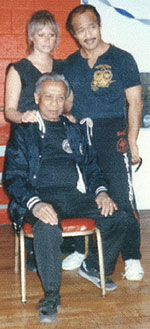
Paula & Dan Inosanto along with Grand Master Leo M. Giron
Following their meeting in the summer of 1970, Dan traveled to Stockton many times, and during the Giron’s vacation, they would travel to Los Angeles to visit Family. During their visits, Dan along with Richard Bustillo and Ted Lucaylucay would pick Manong Leo up and bring him to their academy in Carson to train. Several years later in December of 1973, Dan was the first student to graduate from the Grion system. To this Day, Dan and wife, Paula, and Manong Leo remain very close and still communicate.
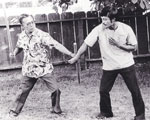
Grand Master Leo M. Giron and Guro Dan playing in the world famous backyard
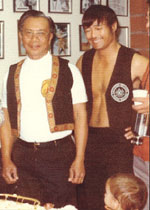
After the first graduation, Grand Master Giron and Guro Dan, December 1973
In 1979, after many years of preparation, the first official meeting of the Bahala Na Marital Arts Association was called to order. The Association is governed by a Constitution and a set of By Laws. Our rule is by majority, and our belief is in the practice of social or economic equality for all the members of the Association. The Association is also dedicated to perpetuate and promote the art of arnis escrima, along with the cluture and history of the Philippines, as taught by Grand Master Giron.
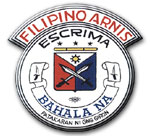
Bahala Na Martial Arts Association Logo
Patakaran Ni GNG. Giron = Creator Giron
Because of Grand Master Giron’s ability to structure the art, and the Association he founded, his master plan is to have his art continue, so the art will live on through all of us forever.
On October 3, 1992, Grand Master Leo M. Giron promoted Tony Somera to the rank of Master. Tony Somera is the only practitioner of the Giron arnis escrima system to ever be awarded the title of master. Once again, at that time, Grand Master Giron was looking toward the future of his Giron arnis escrima system, and the Bahala Na Martial Arts Association, to ensure that his art would continue to exist, and that his work would live on and grow.
Given Grand Master Giron’s health and condition, to ensure that the association would experience little or no transition upon his passing and would grow in the direction he began during his tenure, on December 3, 1992, he promoted Master Tony Somera to the rank and responsibility of Grand Master of the Bahala Na Martial Arts Association.
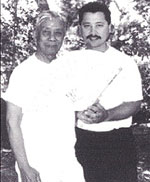
Grand Master Emeritus Leo M. Giron and Grand Master Tony Somera
It is the wish of all Bahala Na Martial Arts Association members to continue to carry on in the spirit of Grand Master Emeritus Leo M. Giron. We will share our art, culture and rich Filipino history with all who would like to learn. The structure and teaching curriculum of the Giron arnis escrima system will continue to live and grow through all of us. Grand Master Tony Somera is currently teaching Giron arnis escrima in Stockton, California, and also conducts seminars throughout the United States and Europe. If you are interested in hosting seminars, or becoming a Giron arnis escrima Certified Affiliate, please visit our website at www.gironarnisescrima.com or write to us at:
Giron Arnis Escrima
P.O. Box 8584
Stockton, CA 95208
209-478-0371
|
In Loving Memory Grandmaster Leovigildo “Leo” Migel Giron August 20, 1911 – May 21, 2002 |
 |
|
|
|
|
Born in Bayambanga little barrio in the province of Pangasinan, Philippines. Passed away in Stockton, California, USA.
|
|
 |
 |
 |
 |
|
|
|
 |
 |
 |
 |
|
|
|
 |
 |
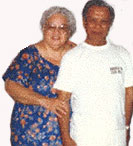

A Tribute To Grand Master Emeritus
written by Tony Somera
On May 22, 2002, one of the last of the bladed World War II heroes passed away. Grand Master Emeritus Leovigildo “Leo” Miguel Giron passed away at the age of 90 years. His story is simple. He did not want too much, just happiness for all. However, his life would prove to be anything but simple. Instead, his life would be a great one, full of adventure and full of the respect from thousands.
Leo Miguel Giron was born in Bayambang, a little barrio in the province of Pangasinan , Philippines , on August 20, 1911. He began his formal training in the martial arts because of neighborhood children and bullies who tried to take advantage of him and others. Giron soon learned that if he stood up to them, and made one of them cry, the rest would run away and leave him alone.
In 1920, young Giron started his education in arnis escrima at the age of 9 years. Many of his teachers were family members, and were experts in both the cabaroan (new style) or cadaanan (old style). They would practice under a mango tree late at night. The payment to practice was a bundle of rice. During their late night training, they would use the light of the moon, and there came a time when this would help Giron to accomplish dangerous missions deep in the jungles of the Philippines during World War II. Most often, the word “play” was used instead of practice, because if asked by others, “What are you doing”? the answer would be, “We are just playing.” This was because not everyone was asked to join in the “playing.” For the most part, young Giron would play without the knowledge of his mother, but after persuasion from young Giron and his father, he was allowed to practice this deadly art. Giron continued to play with his teachers until the time came to leave his homeland.
1906 to 1930 produced the biggest wave of Filipinos arriving in America . On October 20, 1926, at the age of 15 years, Giron boarded the USS President Lincoln and set sail for America . He arrived in Stockton , California with a bag of fruit and 25 cents in his pocket. His first night in Stockton was at the Star Hotel, right off of El Dorado Street in downtown Stockton . At that time, this area had the largest population of Filipinos in the United States , which earned Stockton the nickname, “Little Manila.”
The following day of Giron’s arrival to Stockton , he was offered a job at Terminus Island harvesting celery for 17.5 cents an hour. The regular rate was 35 cents an hour, but due to Giron’s being under the age of 18, he was paid half the regular amount. Giron was also unaware of the cold November weather, and all he had were his island clothes, brought from the Philippines , but he quickly adapted to the weather and social conditions of his new home in America .
In 1929, Giron met a man by the name of Flaviano Vergara. Vergara was from the town of Santa Cruz in Llocos Sur Luzon, Philippines . He was the top student of Dalmacio Bergonia, who defeated the great stick-fighting champion of the Philippines , Santiago Toledo. Vergara and Giron started their training deep in the prune orchards of Meridian , California , continuing from 1929 to 1932. Vergara and Giron would meet again directly after the outbreak of World War II. Their lives would cross for the last time on October 1942, when Giron was shipped out to Fort Ord , California . Every spare minute, Vergara and Giron trained, until Giron was shipped out in January 1943. Vergara was a master in the Bergonia style, and was very proficient in the estilo elastico (rubber band style). Out of all his teachers, he influenced Giron the most, and Vergara’s understanding of the relationships between the cadaanan (old style) and cabaroan (new style) of arnis escrima would prove to be a life saver to Giron later on in his life during World War II. Vergara was also the teacher who gave Giron the Abanico del Maestro (The Fan of the Master).
On June 28, 1937, Leo M. Giron joined one of the largest and most powerful Filipino fraternal orders in America when he was initiated into the Lesionarios Del Trabajo. He started in the Acacia Lodge #637 and later transferred to General Luna Lodge #602 where he was an active member for the rest of his life. The Legionarios Del Trabajo started its first lodge in United States in 1924, in San Francisco , California . Its membership topped the three thousand mark. In all states (including Alaska and Hawaii ) there were 86 lodges, including a dozen for women. The Legionarios Del Trabajo was known for saving money, buying property, and offering benefits to their members, along with social activities for the families and friends of members that shielded them from the social and economic prejudices all Filipinos had to endure during those times.
During the outbreak of World War II, Giron was assigned to General Douglas MacArthur’s group of secret commandos. On July 13, 1942, the First Filipino Infantry was formed in Salinas , California , and on November 21, 1942, the Second Filipino Infantry was formed. Giron was a part of the Second Filipino Infantry. Together, the First and Second Filipino Infantries grew to the strength of 12,000 men. Around 1,000 of these men were selected for special and secret missions. Giron was one of 12,000 men selected, and on November 20, 1944, the first Reconnaissance Battalion was activated. This included the famous 978 th Signal Service Company to which Giron was assigned. These men were called commandos, and “Bahala Na” (come what may) was their slogan. Trained in jungle warfare, Giron and the commandos landed in U.S. submarines at strategic locations throughout the Philippines nearly one year before any other American U.S. soldiers landed in the Philippines . Giron and his company contacted underground organizations, gathered information, and relayed it to MacArthur’s Australian headquarters. They were the secret force and the secret operatives ” the eyes and ears of MacArthur. For nearly a year, Sergeant Giron roamed the countryside of the Philippines and encountered the enemy in hand-to-hand combat, using the expertise that he learned while growing up in the Philippines and America .
Sergeant Giron returned to America as a World War II hero, decorated with many awards and citations. He was awarded the Bronze Star Medal, the Philippine Liberation Ribbon with Bronze Stars, the Asiatic Pacific Campaign Medal, the American Campaign Medal, the World War II Victory Medal, and a letter of commendation ordered by the President of the United States . It reads:
By direction of the President of the United States of America, under the provisions of Executive Order 9419, 4 February 1944 (Sec. ii, Bulletin 3, WD, 1944) a Bronze Star Medal is awarded by the Commander-in-Chief, United States Army Forces, specific to the following named officer and enlisted men for heroic achievement in connection with military operations against the enemy in Luzon, Philippine Islands, during the period indicated with citation for each as shown herein below:
Technical Sergeant Leovigildo M. Giron, 39536996, Signal Corps , United States Army, 27 August 1944 to 11 June 1945. Address: Bayambang, Pangasinan, Philippine Islands . Citation for each of the above named officers and enlisted men is as follows: volunteering for a secret and dangerous military intelligence mission, he was landed by submarine in Luzon, Philippine island, where he assisted in successfully extending lines of communication, securing vital weather data and obtaining military information, which proved of the greatest assistance to impending military operations. By his loyalty, daring and skillful performance of duty under the most hazardous conditions, he readied a campaign for the recapture of the Philippine islands.
* By command of General MacArthur.
* R.K. Sutherland, Lieutenant General , United States Army, Chief of
Staff
* Official: B.M. Fitch Brigadier General, U.S. Army, Adjutant
General.
Sergeant Leo M. Giron was truly a World War II hero, and a proven member of the United States of America ‘s greatest generation.
World-renowned martial arts and Stockton born Guro, Dan Inosanto has said, “Manong Leo brings to his students a rare combination of teacher and fighter. Grand Master Giron is rare; he has a progression he understands. He can teach it, and he can fight with it, because he has survived it through World War II. I think what separates Grand Master Giron from others is that he can teach, he can fight, and he’s technical. These three traits are a rare combination in any martial art.”
After World War II, life for Leo Giron returned to normal. He became deeply involved with the lodge, and held every position. He excelled in his ways of communication so greatly, he became the Grand Lodge Instructor and Lecturer for many years. He had a family with his wife Sally and their children, Christina, Michael, Regina and Thomas.
In 1968, Leo Giron opened his first licensed Bahala Na Club in Tracy , California , where he and his second wife, Alberta , resided. In 1970, he and his wife moved to Stockton , along with his Bahala Na Club.
One of the most famous students to graduate from Grand Master Giron’s class is Guro Dan Inosanto. In early 1970, during the wedding of the daughter of a local Filipino family, Mrs. Mary Inosanto (Dan’s mother) approached Leo Giron to inquire about him teaching escrima. Giron, being a quiet and humble man, listened to Mary about how Daniel was looking for someone to teach him “the real escrima,” meaning the combative style or estilo matador.
Giron’s first reply was that he knew of no one. Mary would not take no for an answer, and replied, “Leo, because of your service in the military during World War II, and the jungle warfare you had to endure, I know you must have the real escrima.” Mrs. Inosanto was very persistent, and finally, Giron gave in and said, “I think I may know of someone who can help you.” He was thinking of someone else at the time – another escrimador from Santa Catalina Ilocos Sur, Philippines named Joe Pacpaco.
That night after the wedding, Mary Inosanto called Dan to inform him of her discovery. That same night, Dan called Manong Leo and informed him that he would be driving up the next day to talk, and hopefully train with him. The next day, Dan showed up with a magazine writer and photographer. They talked, and Giron performed a few techniques with Dan. Dan had found what he was looking for. After that meeting, Dan and Manong Leo became very close friends, and as Dan has said many times, “Manong Leo was like a second father to me.”
Following their meeting in the summer of 1970, Dan travelled to Stockton many times, and during the Giron vacations, he travelled to Los Angeles to visit the family. During their visits, Dan, along with Richard Bustillo and Ted Lucay Lucay would pick Manong Leo up and bring him to their academy in Carson to train. Several years later in December of 1973, Dan became the first student to graduate from the Giron system. Guro Dan and wife, Paula, and Manong Leo remained very close and communicated regularly.
One dream of Grand Master, Giron was to form an association. After many years of preparation, his dream came true. In 1979, the first official meeting of the Bahala Na Martial Arts Association was called to order. The Association is governed by a set of bylaws and a constitution. Its rule is by the majority; its belief is in the practice of social or economic equality for all the members of the Association. The Association is also dedicated to perpetuating and promoting the art of arnis escrima along with the culture and history of the Philippines, as taught by Grand Master Giron.
Leo M. Giron lived a great life – from his young years growing up in the Philippines to his early days in America, his training as an escrimador and his life in the Grand Lodge, his duty in the 978 th Signal and the 2 nd Filipino Infantry Regiment Battalion, and returning to raise a family, his opening of the first Bahala Na Club, and later organizing the Bahala Na Martial Arts Association.
Along with his life accomplishments and the many military awards he received, Grand Master Emeritus Giron also received many civilian awards, numerous awards from the Grand Lodge and the Leginarios Del Trabajo in America, including being awarded 33 rd degree on August 27, 1941 (this being the highest level in the Grand Lodge) along with the Worshipful Master Certificate on October 26, 1968. There were also many awards recognizing his achievements in the martial arts field from many different martial arts organizations and groups.
On September 4, 1975, Toastmasters International Highest Honors awarded Giron. His church, and the President of the Trinity United Presbyterian Mens’ Group also recognized Giron by giving him the award of Father of the Year on June 5, 1997. On August 11, 1998, Giron was named to the Supreme Honor Roll awarded by the Filipino American Historical National Society. He also received outstanding recognition for services performed in his community by Mayor Gary Podesto of the city of Stockton, California, Tom Bradley, Mayor of Los Angeles, California, and former Governor of the state of California, Pete Wilson. Leo Giron was given so many awards, the list seems endless.
The following statements are those of our Bahala Na Martial Arts Association members. We would like to share these with you, so that those of you who never met Grand Master Giron will know him through us. For those who did know him, you will remember your special times with him.
Everyone who knew him knew of this great man in many different ways. He was our uncle, our brother, teacher, mentor, adviser, World War II hero, husband, soul mate, leader, warrior, grandpa, and a living history of knowledge. He was caring and gentle, honest and loyal with the greatest of dignity. He taught us to understand our own fathers’ generation. He was humble and loving, and he was my very best friend. Even so, he was so much more to many more people.
We will remember Grand Master Emeritus Leo through his great teachings, and through the system he created. We will remember the wonderful times playing in the backyard during the hot summer and in the basement during the cool winter months. We will remember the times when Grand Master Emeritus would pick up the stick and clear the playing floor with his combat larga mano.
We will remember the wonderful smell of Alberta’s cooking of abodo and sinigong. We will remember the times of close conversations about history, culture, and especially life. We will remember the priceless times of going to the store, riding to the pharmacy. We will remember the dearest times of going to lunch and ordering bitter melon or chicken with black mushrooms. We will remember going on Bahala Na road trips to demonstrations, workshops and seminars and seeing Manong Leo work the floor, teaching another generation of escrimadors. We will remember the smile and joy he would bring to all of us. We will remember the jokes and the stories. We will remember after a seminar, how he would take off his shirt and pose like a body builder and say, “You know, in the army they used to call me Little Atlas,” and there were the scars from a car wreck, open heart surgeries and combat wounds. We will remember running around in our hotel room in our under clothes acting like teenagers. We will remember all the special gifts he gave us. We will remember that Manong Leo never advocated a style of superiority, but he knew what was useful in battle and lived to tell it. We will remember the practicality of Manong Leo’s technique, and how it paralleled his perspective on life by keeping it simple, right to the point, to do what it takes to get you through. We will remember how he would keep things simple; this is what made his system so powerful and effective. We will remember his smile. We will remember how he made us feel so welcome in his Bahala Na family. We will remember his sayings like, “You will be lucky if you hit him at all,” or “Peace is not without conflict. It’s the ability to cope with conflict and learn to conserve your energy. You have a lot of people to fight today.” We will remember how he always made it fun as you learned. We will remember the phone call and e-mail informing us of his death.
It is the wish of all Bahala Na Martial Arts Association members to continue to carry on with the spirit of Grand Master Emeritus Leo M. Giron. We will share our art, culture and rich Filipno history with all who would like to learn. The structure and teaching curriculum of the Giron Arnis Escrima System will continue to live and grow through all of us. Because of Grand Master Giron’s ability to structure the art, and the association he founded, his master plan was to have his art continue, so the art would live on through all of us forever.
On October 3, 1992, Grand Master Leo M. Giron promoted Tony Somera to the rank of Master. Tony Somera is the only practitioner of the Giron Arnis Escrima System to ever have been awarded the title of Master. Once again, at the time, Grand Master Giron was looking at the future of his Giron Arnis Escrima System, and the Bahala Na Martial Arts Association to ensure that his art would continue to exist, and that his work would live on and grow.
On December 1, 1999, given his health and condition, he used his ability once again to structure the art he founded that would assure the Association had little or no transition upon his passing, and to ensure that the Association would endure the growth of direction he began during his tenure, Master Giron promoted Master Tony Somera to the rank and responsibility of Grand Master of the Bahala Na Martial Arts Association.
“If God made man in his image, God had an outstanding day on August 20, 1911 when he created Leo M. Giron.”
FAREWELL BY GURO DAN INOSANTO
I love this man. Manong Leo was like a second father to Paula and me; Grandpa Leo, to our daughter Danielle. He has been my advisor, counsellor and Guro. He was a problem-solver for me. I could call him anytime and ask for advice and guidance on any problem. He was always there for me, with his wisdom, strength and humor, and he never failed to help or guide me.
He instilled in me great pride in being an American Filipino, and helped me to gain a deeper understanding and appreciation for my Filipino culture and heritage by teaching me the Filipino martial art. Manong Leo was instrumental in giving me the incentive to further research, promote and teach the Filipino martial arts to others. Manong Leo was truly a HERO, not only to the Filipino people and the American born Filipinos such as myself, but for all Americans. His distinguished and courageous service to our country during time of war has always inspired me. Manong Leo influenced for the better, so many people. His legacy will live on. His art, in the capable and strong hands of Tony Somera, will thrive and continue to grow and educate the martial arts community, and all those who study and train in the arts. Many generations to come will benefit from the time Manong Leo spent with us. And while I wish he could have stayed with us awhile longer, I thank God that He allowed me the honor and privilege to spend as many years as I did with one of the kindest, wisest, and humblest human beings it was my privilege to know. God bless you, Monong Leo.
Sincerely
With Love,
Dan Inosanto
Grand Master, Tony Somera, is currently teaching Giron Arnis Escrima in Stockton, California, and also conducts seminars throughout the United States and Europe. If you are interested in hosting seminars, or becoming a Giron Arnis Escrima Certified Affiliate, please visit our website at www.gironarnisescrima.com or write to us at:
Giron Arnis Escrima
PO Box 8584
Stockton, CA 95208
Phone: 209-478-0371
Edgar Sulite
written by Dan Inosanto
I first met Punong Guro Edgar G. Sulite on August 14, 1989 in Indian Creek, Tennessee, during a Pekiti Tersia Kali Camp conducted by Grandmaster Leo T. Gaje, Jr. Both Punong Guro Sulite and I are long time students of Grandmaster Gaje. Punong Guro Sulite and I both taught a portion of this camp along with Grandmaster Gaje. It was at this time that I received my first (of many to come) private lessons in the art of Lameco Eskrima.
When the camp ended, Punong Guro Sulite relocated to the Los Angeles area. Upon his arrival in Los Angeles, I began my private training on a continuing basis.
I took great pleasure in watching Punong Guro Sulite and his art of Lameco grow in the area of the Filipino martial arts. In my opinion, Punong Guro Sulite’s system of Lameco has one of the most practical and highly developed progressions of teaching and training.
Lameco takes a student from “A” to “Z” in such an organized and ejoyable progression that training and learning is both fun and practical. The Lameco methods and progressions enable a student to learn both quickly and efficiently what will work and what is applicable in a multitude of combative situations. I credit the outstanding contribution Lameco has added to the martial arts community to the vision, talent, creativity and unparalled devotion and dedication of Punong Guro Edgar Sulite.
I remember the early years of Lameco. Punong Guro Sulite always credited with love and respect the great talents and valuable training he had received from the Grandmasters of the Philippines who had trained him, and always gave proper respect and acknowledgement to the techniques, drills, methods and material that was developed by those men, and which he used to form the core of the Lameco system.
What was unique about Punong Guro Sulite was the manner in which he was able to combine practically and efficiently the knowledge he had received form the Philippines. Upon his arrival to the United States, Lameco’s “Laban Laro” had a sequence of only 12. Punong Guro Sulite worked constantly to add, modify and develop his inmeasurable body of Filipino martial arts material until it had reached the highest level of practicality and value to his students.
Punong Guro Sulite always stressed the importance of drilling the basics — over and over again.
Reprinted from FREE VOICE
Donald Hillard
INOSANTO INTERNATIONAL MARTIAL ARTS
INSTRUCTORS ASSOCIATION SPOTLIGHT
ON NEW INSTRUCTOR
Inosanto Academy Member
Donald P. Hilliard
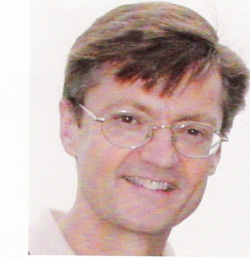
A Southern California native, Don Hilliard has explored and trained in various martial arts over the past 35 years. In the early 1970’s, he attained the rank of Black Sash Instructor in Silum Tai Chi Kung Fu and taught classes in this system in Ventura and Simi Valley, California. Don also trained in Western Boxing, Aikido, Judo, Tae Kwon Do, Hwa Rang Do, Shotokan Karate and fencing. Early in Don’s martial arts experience, he became fascinated with the teaching of Dan Inosanto through his published writings – incorporating the methods and principles into his own training. Over the years, Don has taught martial arts to others privately. Since the mid-1990’s, Don has trained at the Inosanto Academy of Martial Arts. He presently trains in the areas of Filipino Martial Arts, Maphalindo Silat, Majapahit Martial Arts, Muay Thai Boxing, and Jun Fan Gung Fu. He teaches these arts in Camarillo, California.
For the past 25 years, Don has been an engineer and manager for research and development of advanced military systems for the United States Department of Defense. His technical expertise is in the areas of radar, electromagnetics, antennas, high-speed solid-state electronics, electro-optics/photonic sensors, lasers, and infrared systems. During the late 1970’s and early 1980’s, Don served 5 years in the United States Air Force in the area of Intelligence Operations.
Don received a Bachelor of Science Degree in Electrical Engineering and Computer Science from the University of California, Berkeley in the mid-1980’s. In 2004, Don received a Master of Business Administration Degree from the Massachusetts Institute of Technology Sloan Fellow Program.
Don is a Senior Member of the International Electrical and Electronics Engineering (IEEE) Society, the Antenna Measurements and Techniques Association (AMTA), Eta Kappa Nu (Electrical Engineering Honor Society), and Tau Beta Pi (Engineering Honor Society). He received 2 United States Air Force Commendation Medals during his service time. He holds eleven United States patents, has written numerous papers for technical publications, and has received various professional awards.
Don resides in Camarillo, California with his wife and two children.
John Maidment
written by C.P. Bergman
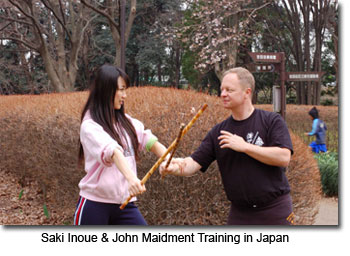 John Maidment is a registered nurse, photographer, and martial artist with an Associate Level in Filipino martial arts and Jun Fan Gung Fu and an instructor rank in Maphilindo Silat under Guro Dan Inosanto, as well as instructorships from different organizations under different individuals. He has written several student manuals for his school, as well as handling everything else: posters, ads, newsletters, brochures, business cards, flyers, etc., which were all done by typing, hand drawing or on electraset (rub-on lettering). He kept attendance records and financial records, with the assistance of Valerie Smith, who for awhile was his training partner, and eventually became certified.
John Maidment is a registered nurse, photographer, and martial artist with an Associate Level in Filipino martial arts and Jun Fan Gung Fu and an instructor rank in Maphilindo Silat under Guro Dan Inosanto, as well as instructorships from different organizations under different individuals. He has written several student manuals for his school, as well as handling everything else: posters, ads, newsletters, brochures, business cards, flyers, etc., which were all done by typing, hand drawing or on electraset (rub-on lettering). He kept attendance records and financial records, with the assistance of Valerie Smith, who for awhile was his training partner, and eventually became certified.
CPB: How did you become interested in the martial arts?
JM: I was getting bullied in school, and started training in judo. I later added aikido and karate. During this time, I became aware of Bruce Lee through the movies and martial arts magazines. As I began to educate myself on the different martial arts, I became disillusioned with karate. I had also left judo and aikido, and began training on my own and with others. Eventually, in 1978, I travelled to Aspen, Colorado to attend a one-month camp, where for two weeks I trained under Remy Presas in modern Arnis, and two weeks under Richard Bustillo in Filipino martial arts and Chinese kickboxing. Two years later, I went to California and met Sifu Dan Inosanto for the first time, and since then, I’ve concentrated on my training under Guro Inosanto and instructors associated with him. Through the years, I have seen the curriculum evolve to incorporate many martial art styles and systems, all of which are street-effective, and while different in approach, share many similar principles and concepts. Guro Inosanto will often illustrate various options from these arts, without blurring their origin. One of the things that blew me away was the introduction of Thai pads to our training. I had not seen them prior to a trip to the Filipino Kali Academy in the early 80’s. As I reflect back on this, it doesn’t surprise me because Guro Inosanto was always looking and researching other martial arts to find the effectiveness of techniques, drills and training methods, including the use of equipment. Guro Inosanto was a pioneer in exposing his students to the concept that is now called Mixed Martial Arts. Even in the 1980’s, during sparring we were flowing in and out of grappling and kickboxing, and occasionally even training with weapons would be included in the mix.
CPB: I’ve heard you were determined to make it to seminars, and even managed to make it to one in spite of being waylaid by an auto accident!
JM: During the time that I was frequently attending seminars, I would often push myself, sometimes driving for 12 hours straight, with minimal breaks, even if I’d worked the day before. On one certain occasion, I pushed too far. There was a seminar in Montreal. I’d gotten off that morning from work, stayed up all day, and started to travel to Montreal in the evening. By 5:00 a.m. the next morning, despite several periods of rest, I fell asleep at the wheel and managed to ‘total’ my truck. Luckily, I was not injured. The police gave me a ride to the nearest major city. From there, I took the bus to Montreal, and made Guro Inosanto’s seminar on Sunday.
Another interesting Montreal story happened on a Friday when I was enroute to a seminar on Friday, and the engine blew on my van. In order not to miss the seminar, I got towed to the nearest town where I purchased another vehicle with my credit card!
CPB: Do you think being adept at martial arts has helped you in your career as a nurse?
JM: Yes. I work in the emergency room, and have had to take down people on numerous occasions. One particular incident in Toronto involved a drunken individual who came in and threatened to kill his pregnant girlfriend, and threatened to rape the front desk nurse as well. They called me in, and when he came at me I met him with several leg kicks, which didn’t hurt him, but stopped him. All the other incidents were restraints, such as choke holds and wrist locks. Once, a psychiatric patient was beating up a nurse on the elevator. I intervened and was able to take him down with a choke hold and arm bar, until he was sedated by other nurses.
CPB: How have seminars changed from the 80’s and 90’s to now?
JM: In the early days, people were not as exposed to different martial arts, so you’d see their mouths drop open in amazement during Guro Inosanto’s seminars. It was like turning on your television set and getting live feeds from 30 different channels at once. There were more skeptics then, because for instance, traditional karate was still quite prevalent, and the belief was that you had to be more robotic to be a ‘real’ martial artist. For us to be training in sweats and sneakers and bouncing around on the floor was still a phenomenon that many people were not used to. People training back then were more interested in learning and exploring the arts, while over time, it seems like more people have become more interested in stealing the technique and incorporating it into their curriculum, or opening a school and not necessarily giving credit where it’s due. A small portion is interested in actually, legitimately, pursuing instructorship.
CPB: What has kept you interested in training with Guro Inosanto for over 20 years?
JM: The main reason I stayed with Guro Inosanto is that I have found him to be the most honest and knowledgeable person in the martial arts that I’ve ever met. For example, if he shows you a move, and it comes from another martial artist, he will tell you where it came from. With him, there is absolutely no attempt to misrepresent himself or his knowledge. I have also been at other seminars or training sessions where he has been a student along with the rest of us, and he approaches the training without prejudice and is simply happy to be learning and training. This has served as an inspiration to me.
CPB: What influenced you to move from Canada to the States?
JM: Before moving to America, I had frequently attended seminars throughout the U.S., including the Academy in Los Angeles. So, by 1996, with Canada’s health care system in turmoil, and nursing jobs being scarce, I decided to pack up and leave. Eventually, I secured work in Los Angeles and have been here since 1997.
CPB: Where have your training travels taken you in the U.S.?
JM: Including flying and driving, I have attended Guro Inosanto’s seminars in New Hampshire, New York, Pennsylvania, New Jersey, Florida, Maryland, Illinois, Indiana, Wisconsin, Oregon, Ohio, Michigan, Virgina and Los Angeles, as well as several Canadian provinces.
CPB: Were there other influences or individuals in your martial arts career that you would like to mention?
JM: Obviously, all my former and current students; my seniors at the academy, and on the seminar circuit; and the other instructors whom I have been privileged to train under, including Guro Paula Inosanto, who has supported me and provided me with opportunities to grow as a martial artist. At times, she went out of her way to insure that myself and any students I’d brought with me, were introduced to the seminar host, and made to feel welcome. Being coached by her was enjoyable and productive because she would not take it easy on me, but took the time to teach the technique if I didn’t know it. More recently, she has also encouraged me to pursue my newfound interest in photography.
CPB: What advice do you have for others regarding training?
JM: Try not to burn yourself out. Re-evaluate your goals and train accordingly.
Paul Finn
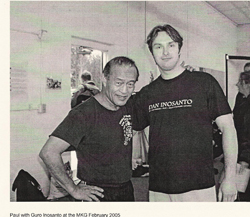
Paul Finn began studying martial arts at the age of 12 in judo, under the tutelage of Professor Seiji Morioka (8th Dan) Founder and Head Instructor of the Musokai Association of Original Japanese Martial Arts. After several years of judo, he broadened his stiudies with Shotokan Karate, training into his late teens with the Thames Shotokan Karate Organization under Sensei Raye Fuller. During this time, he was invited to learn Bujutsu with Professor Morioka. His training incorporated Ju-jutsu, Kenjutsu/Laijutsu and Bojutsu. After a number of years, Paul says he was “proud and privileged to be awarded the rank of Shodan by Sensei Morioka in both Kendo and Bujutsu.”
In his late teens, Paul was diagnosed as suffering from an arthritic condition, which caused him to experience painful inflammation of the joints, particularly the lower back. Unfortunately, this curtailed his martial arts endeavours to some degree, and was frustrating to him, but at the same time, he went on to study law, entering Lancaster Gate Law School, where he successfully passed the Law Final Exams. This allowed him to qualify as a Solicitor of the Supreme Court in October of 1995.
Paul Finn has been a practicing Solicitor for the past nine years, and is employed as the head of Personal Injury Litigation in a busy provincial firm.
During law school, Paul renewed his martial arts studies and became heavily involved in Wing Chun Gung Fu. He originally studied at Moy Yat’s Kwoon in London, and went on to study with Sifu Steve Marie before joining the Kamon organization under the tutelage of Sifu Kevin Chan. In 1996, he visited Hong Kong and the Philippines. During this vacation, he studied at the Yip Chun Athletic Association in Hong Kong, training personally with Grand Master Yip Chun.
After this, Paul continued his studies with Sifu Steve Marie, who introduced him to the art of Jeet Kune Do. At this time, he also began attending Guro Dan Inosanto’s seminars in the United Kingdom, at the Bob Breen Academy in London. He also began attending Sifu Rick Faye’s seminars. These came as a breath of fresh air from the traditional systems into which he’d historically been involved.
In 1997, Paul’s Wing Chun instructor, Steve Marie, left the UK to live in Denmark and Paul began studying (upon Steve’s recommendation) with Guro Ralph Jones of the Kent Kali Group.
Paul Finn has attended numerous JKD seminars at home and abroad over the last 8 years, including summer camps hosted at Bob Breen’s Academy, and Guro Inosanto’s seminars in London, Edinburgh, Glasgow, Bournemouth, Spain, Germany and the United States. He has visited Guro Rick Faye’s Minnesota Kali Group, and the Inosanto Academy of Martial Arts in Los Angeles, California, where he has attended Guro Inosanto’s classes and the IAMA Instructors Camp in 2006. Paul says, “These have been fantastic opportunities to learn, especially at the legendary Inosanto Academy under the direct tutelage of Guro Inosanto.”
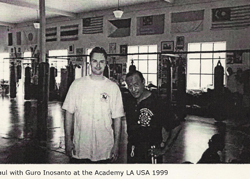 For the past five years, Paul has studied as a private student (alongside Guru Raph Jones) with Grandmaster Danny Guba of the Doce Pares system of Eskrima.Kali.Arnis. He has been certified by Grandmaster Guba to 3rd Dan in this multi-system style. Over the past three years, he has trained with Ibu Rita Suwanda, the head of the Mande Muda Pencak Silat Association. One of his goals is to become part of the Mande Muda program and promote the growth of this art throughout the UK.
For the past five years, Paul has studied as a private student (alongside Guru Raph Jones) with Grandmaster Danny Guba of the Doce Pares system of Eskrima.Kali.Arnis. He has been certified by Grandmaster Guba to 3rd Dan in this multi-system style. Over the past three years, he has trained with Ibu Rita Suwanda, the head of the Mande Muda Pencak Silat Association. One of his goals is to become part of the Mande Muda program and promote the growth of this art throughout the UK.
Recently, Paul trained with Sifu Joseph Lee of the Lee Shing Wing Chun lineage as a closed-door student.
Paul Finn has been teaching part-time for the past five years, and hopes to develop and increase his student base over the coming years.
Donn Draeger
written by Mike Belzer
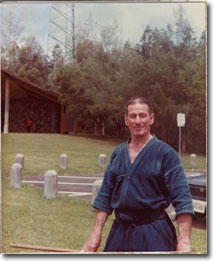 Most people involved with the study of fighting arts are familiar with the name Donn Draeger . For some, they only knew him as ìthat guy who wrote all those martial art booksÖî. To others he was one of the most highly trained, knowledgeable and experienced professional warriors they ever met. Through out his life he focused his energies on the fighting arts. In fact, Donn Draeger became known as the founder of modern hoplology. Not to be confused with the ìstudy of bunniesî, the term hoplology is derived from the Greek warriors known as ìHoplitesî. The current definition of hoplology is: the study of the evolution and development of human combative behavior and performance.
Most people involved with the study of fighting arts are familiar with the name Donn Draeger . For some, they only knew him as ìthat guy who wrote all those martial art booksÖî. To others he was one of the most highly trained, knowledgeable and experienced professional warriors they ever met. Through out his life he focused his energies on the fighting arts. In fact, Donn Draeger became known as the founder of modern hoplology. Not to be confused with the ìstudy of bunniesî, the term hoplology is derived from the Greek warriors known as ìHoplitesî. The current definition of hoplology is: the study of the evolution and development of human combative behavior and performance.
Donn Draeger was recognized as a world authority on Asian martial culture and human combative behavior. As a research historian, author and lecturer; he was considered the leading exponent of the Japanese martial disciplines. He held a large number of expert ranks and teaching licenses, and investigated Japanese martial culture more deeply than any non-Japanese in history:
- Draeger was the first and only non-Japanese to hold the rank of ìBudo Kyoshiî or Full Professor of the Classical Martial Arts and Ways.
- He was designated as the first non-Japanese Judo Instructor at the Kodokan Institute in Tokyo, Japan.
- Draeger was the first non-Japanese to demonstrate kata (as tori) at the All-Japan Judo Championships and the 1964 Olympic Games.
- He was also the first non-Japanese to compete in the ìAll Japan High Rank Holdersî Judo tournament at the Kodokan.
Born on April 15, 1922, Donn grew up in Wisconsin and began his martial training in the art of Jujutsu at a very early age. He soon switched to the practice of Kodokan Judo and received the rank of nikyu by the age of ten. He continued his involvement with Judo throughout his life.
During the summer months Donn was able to hunt, fish and live with the Chippewa Indians who lived in the Wisconsin wilderness. The older tribesmen accepted him because of his skill in grappling and his ability to handle youths older and larger than himself. His fascination with weapons developed at an early age, along with his skill in unarmed encounters. Saving money from a variety of odd jobs, Donn bought his first .22 rifle around the age of 11 or 12. He roamed the woods ìplinkingî and hunting small game. His skill eventually developed so that he could usually shoot from the hip more accurately than those who followed the usual sighting procedure.
At young age of 15, Donn joined the United States Marine Corps and eventually rose through the ranks as a regular officer. He served in Japan, Korea and Manchuria. While in the Marines he continued his formal education and received his masterís degree in electrical engineering.
His interest in hunting also continued while he was in the Marine Corps. Donn hunted big game on all of the major continents. He accumulated 44 heads including the Grizzley and the Alaskan Brown Bear. Later however, Donn grew to detest the idea of hunting animals other than for defense or subsistence.
After retirement from the service, Donn made his home in Tokyo, Japan. From this base he pursued his interests in martial training and research. Approximately four months out of each year was spent conducting expeditions to various countries to study and document their diverse combative traditions. Southeast Asia was an area of special interest to him.
Donn followed a simple and natural lifestyle. He neither smoked nor drank and he had no heat or air conditioning in his small Japanese style apartment. He got up with the sun and usually jogged around his hometown of Narita. The rest of the day was spent training, teaching and conducting research.
A significant contribution was made to the art of Judo when Donn introduced systematic weight training at the competitive level. The impact was such that now all Judo champions utilize weight training as an integral part of their overall program.
ìPoliticsî at the local and international level within the Judo world spurred Donn on to pursuing and eventually gaining acceptance into Japanís koryu (ancient disciplines).
He was the first Caucasian allowed to enter the koryu and eventually became a licensed instructor of Shindo Muso Ryu Jodo (Stick Art) and Katori Shinto Ryu Kenjutsu (Sword Art). Later, Donn introduced Jodo training to Malaysia and also began the U.S. Jodo Federation.
A prolific writer, Donn would spend up to 15 hours a day typing. He authored many books and was a contributor to numerous scholarly journals and magazines. His most well known books include Asian Fighting Arts and his three volume series on The Classical Martial Arts and Ways of Japan.
Donn was a contributing editor to the publication known as ìJudo Illustratedî and he also published a magazine titled ìMartial Arts Internationalî. Later, he also published the official newsletter of the International Hoplological Research Center.
As time went on, Donn became increasingly ìlocked intoî his chosen profession as a researcher and exponent of martial culture. When he would return from his annual expeditions he would have up to 100 lbs. of mail waiting for him ñ letters relating to the study of combatives; and he answered them all.
The final goal of Donn Draeger was to reformulate the study of weapons and fighting systems into a recognized academic discipline known as Hoplology. He was the one that could accomplish the task because of his lifetime of training and personal experience in the area of combatives.
His scholarly research provided the historical and cultural context for his hoplological conclusions. He founded the International Hoplological Research Center and developed ambitious plans for a permanent facility to be constructed on the Big Island of Hawaii.
The center would serve as a training site for a variety of combative traditions and also house facilities for analyzing the hoplological data gained through fieldwork. In addition, ìthe archivesî of the center would house the most extensive collection of representative weapons in the world. Over 10,000 separate books would be the start of a library for the center. Donn maintained the worldís most extensive collection of wood block prints depicting the warriors of Japan. These prints would very likely be on display in the archives.
The development of hoplology continued with Donn serving as a guest lecturer at the University of Hawaii, the University of Maryland and the East-West Center on a regular basis. He trained a variety of individuals scattered throughout the world in hoplology theory and methods. He took a number of individuals with him on his annual expeditions so they could be oriented to the foundation of hoplology ñ fieldwork.
Fieldwork into the remote areas of the world carries a significant degree of risk. Bad luck finally found the 1979 research team while they were in Sumatra. While studying the Atjeh tribe, the entire team was poisoned and developed severe amoebic dysentery which required hospitalization.
The team eventually recovered but Donn continued to develop health problems. He had severe swelling and pain in his legs. His health gradually deteriorated to the point where he was diagnosed as having cancer. On October 21, 1982 Donn Draeger passed away at the age of 60.
The development of hoplology has continued through the efforts of several hoplologists who were personally trained by Draeger while on extended field expeditions, primarily in South East Asia. The International Hoplology Society (IHS) is directed by Hunter B. Armstrong who was a senior researcher under Donn F. Draeger and accompanied him several expeditions, including the fateful one to Sumatra in 1979.
A detailed biography of Donn Draeger is in the process of being published and will be released soon. For more information on Donn F. Draeger and hoplology, please contact The International Hoplology Society website at: www.hoplology.com
Remembrances of My Sensei: Donn Draeger
written by Mike Belzer
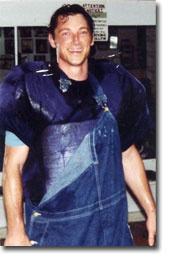
MPB’s Background:
1965 – Began training in Kodenkan Jujutsu at age nine.
1974 – Lived in Japan for nine months training in Shindo Muso Ryu Jodo and Uyeshiba Aikido
1979 – Traveled to Malaysia with Donn F. Draeger for three weeks studying hoplology (the study of weapons and fighting systems).
1980 Began training in the weapons based art of Filipino Kali under Guro Dan Inosanto
1984 – Traveled to the Philippines for a three-month expedition to research Filipino Kali, Escrima and Arnis using the hoplological methods I learned from Donn F. Draeger.
1989 Became apprentice instructor of Filipino Kali under Guro Dan Inosanto.
1989 – Returned to Malaysia for the second time to revisit the original teachers that Donn Draeger Introduced me to in 1979.
1990 Began training and teaching, full force self defenseusing complete protective gear. The focus is on adrenal stress conditioning using realistic scenario training.
2007 – Traveled to Thailand, Malaysia and Japan for three week research tour.
Currently: Director of Training for The Realistic Scenario Training Corp. RST acts as a consultant
For the Los Angeles Police Department as part of the LAPDís Civilian Martial Art
Advisory Panel (CMAAP).
I saw Donn Draeger for the first time when I was 13 years old. My father had heard that some top ranked martial artists from Japan were coming to Bethesda, Maryland to give a demonstration. Since my father, my older brother and myself were all exponents of Kodenkan Jujutsu at that time, we were all looking forward to seeing this demonstration. The year was 1969 if I remember correctly.
All I really remember of the demo was an old Japanese man (Shimizu Takaji) and a big Caucasian (Donn F. Draeger) who was wielding a strange looking weapon called a kusarigama (a combination weapon with a sickle and weighted chain), which fascinated me. I had no idea who these men were besides expertsfrom Japan. This was one of the first times both classical budo and bujutsu were shown outside of Japan. I wasnít aware of it at the time, but I saw Shindo Muso Ryu Jodo and Katori Shinto Ryu Kenjutsu demonstrated for the first time in Maryland.
Later, I obtained Dreager and Smithís book Asian Fighting Arts. This book was amazing to me. All these styles and systems from all over the world looked so interesting to me, I wanted to learn them all
My next encounter with Donn Draeger occurred in 1974 at age 18. I had just graduated from high school and I had the opportunity to travel to Japan and train. My father suggested that I write to Donn since he was based in Tokyo. I sent a letter to him in care of his publisher and had no idea if the letter would even get to him. A couple of months before I left, I received a polite response from him: Your letter has finally sifted down to me from my publisher. What did you have in mind? I await your reply.Signed Donn F. Draeger.
I immediately returned a letter stating my intention to go to Japan to study the martial arts. In his reply he told me that he would help me in any way that he could. He wrote: Keep in mind that what you are doing in the U.S. is probably very different from the way things are done in Japan. All you have to do is keep an open mind and let the Japanese show you their art.He told me that he would be doing research in Borneo when I arrived in Japan but he gave me the number of Howard Alexander to contact when I arrived.
I arrived in Japan, contacted Howard and was taken to his stick fightingdojo. This was the Rembukan dojo where Shindo Muso ryu jodo was taught as a koryu with Shimizu Takaji as the headmaster. At that time I did not make the connection that this was the same man I had seen demonstrate with Donn five years earlier in Maryland.
I trained in jodo at the Rembukan dojo for about three months before I heard Donn is back from Borneo and will be here next week. Someone also had mentioned When he takes off his shirt, you wonít believe it. Even at age 53 (or so) his muscle development is awesome. Well, they were right. Donn showed up, peeled off his shirt to get into his keiko gi and I am sure my mouth fell open.
That day we trained a bit together in jodo. I was impressed at how this big strong guy moved so smoothly with power. He always provided just the right amount of resistance for me. He didnít over power me and he didnít ëgive it awayeither. He made me work, but the work was efficient. After the training session ended, I introduced myself and told him Iím the guy who wrote you from CaliforniaHe smiled and said that he was glad that I had indeed come to Japan and was studying Jodo. Then a funny thing happened. I saw Donn and Shimizu-sensei together for the first time side by side. I finally made the connection and blurted out Hey! I know you guys! You were both at the demonstration I saw in Maryland in 1969! They both got a smile on their faces from that one.
Another funny incident that happened at the dojo was also at the end of a training session. Several of the guys who trained at the dojo were intohealth food, brown rice and were vegetarians. Donn took off his gi (muscles rippling) put on his street clothes and looked around at the people in the dojo. He smiled and said, All right, whoís ready for some garbage? We all got on a bus and headed out for pizza.
I saw Donn at the dojo several times, trained with him and listened to stories from his latest expedition. I heard about a tussle he had with a combat tai chi man he called The Butcher. Apparently the tai chi butcher had started to push Donn, so he responded with a footsweep that unbalanced him and got his attention. I heard later that the two of them ended up in another skirmish that knocked a sink off the wall. The thing I remember most was that I was unable to really look at his eyes. His whole presence was very intense for me and I counted myself lucky to just ride in the same bus with him.
In May of 1975 I left Japan after nine months of training in Jodo and Aikido to return to Los Angeles for my university education at UCLA. It was at that time that Donn first told me about hoplology and that its development would need young men like yourself.I told him I was interested and that I would write to him when I returned to L.A.
Over the next five years I corresponded with Donn either asking questions about hoplology or helping him with his courses at the University of Hawaii by writing letters of interest to the appropriate departments. In 1979 I received an invitation to attend the First International Jodo Jamboree to be held in Malaysia. I had in my mind that I would be at the end of a crowded football field filled with martial artists from all over the world. Iím sure I would barley be able to see him from where I would be but I was also sure that I wanted to go to this jodo camp. I wrote to Donn that I wanted to attend and told him of the travel plans I would make to get to Malaysia. He wrote back that if I wanted I could come to Japan instead and travel the cheap way like I do. We will fly to Thailand and then take the 25 hr. train ride from Bangkok to Penang, MalaysiaI thought Wow! I just received a personal invitation to travel with him to Malaysia! This is a must trip!
Donn met me at the airport in Narita in July of 1979. This time I was able to look him in the eyes. He knew I was there because of my interest in Judo and Hopology.
We had some dinner and I then conked out in one of the two rooms (61 D2 and 4 mat rooms) of his small Japanese apartment. I learned that he has no heater and no air conditioner in his apartment. He trained in Katori Shinto Ryu Kenjutsu every day and walked six to eight miles a day. He did not smoke drink alcohol or even coffee. Not because of any hang-ups, he just didnít like what they do. He said that liked the waterproof and floatable camera I brought him but what he really liked were the homemade chocolate chip cookies!
I woke up early and looked through some of his books as well as a lot of photographs from previous expeditions. He told me that he was working on a two-volume book about Penjtak Silat of Malaysia and Indonesia. He said that it would go into much more depth than the other book he had written on Petjak Silat with Howard Alexander and Quinten Chambers.
Donn took me to a hospital in Tokyo to visit with Watatani- Sensei. Watatani
was probably the most knowledgeable budo historian living at that time. He had completed a 900-page book delineating over 10,000 ryu and headmasters. Watatani was very ill and Donn was afraid it would be the last time he might see him. Watatani-sensei was sitting up in bed cross-legged and his eyes lit up like a little kid when he saw Donn walk in. He really made his day!
After two days in Japan we flew to Bangkok and boarded a train for a 25 hr. trip to Butterworth, Malaysia. It was just the two of us and I took the opportunity to interviewhim about hoplology. I had a list of 28 questions and I asked him if he minded answering some questions. Fire away.He said. I made notes on the topics he covered: The macro analysis of a weapon and a system; the typology and descriptions, the group, genus, type and subtype of weapons and systems. Then he gave me a field notebook and told me to memorize as many weapons and names as possible because we would be seeing these weapons on this trip.
We also discussed the four endsof a system:
1. Shiai Competition
2. Goshin Self Defense
3. Satori Enlightenment
4. Shobu- Killing/Lethal
Donn made it clear that you can really have just one end. One of the four. If you claim to have more than one of them you end up with none. We talked about fear, confidence, experience and fudoshin (immovable mind). He said that knowing yourself is a product of proper training under a qualified teacher for a protracted length of time.
The head of Malaysian Jodo Karunakaran, met us at the train station in Butterworth. He had been a student and friend of Donnís for many years. We had some dinner and got situated and the next day we were off to Taiping to begin the Jodo Jamboree. There were representatives from Switzerland, New Zealand, Japan, Malaysia, Singapore and I represented the United States for that year.
Training at the 5-day camp consisted of three training sessions a day plus a lecture portion and then some evening activity like a demonstration from local martial artists from different styles. My concentration was in the omote or first level of the jodo curriculum. I met many great people during the camp and I saw how Donn trained the instructors as well as the beginners. He met each of us at our own level and then pushed us just a little farther then we thought we could go. At one point he surprised me by telling me I would be tested for my sankyu rank the day before the test. Everyone else had been preparing for the test for days. I heard later that one of the things Shimizu-sensei would do to Donn is change the kata he was to demonstrate on the day of the demonstration! Be prepared at all timeswas his message to me.
After the camp Donn took me to see several master teachers so I could observe their styles and training methods. We visited:
1. Chy Kim of the Sao lim.
2. Master Leong and Master Tan of the Pheonix Eye Fist.
3. Master Rahman of the Silat Seni Gyung.
4. Master Lee Pit Lai (The Butcher) of Combat Tai Chi Chuan.
5. Master Abananthan of Indian Silambam.
What can I say about the opportunity I had to travel with Donn Draeger? It was simply the greatest experience of my life. I made a promise to myself that within three years I would return to participate in the three month expedition that Donn made each year to continue his hoplological research and train new hoplologists out in the field.
I found out four months later that the whole team that left with Donn after I returned to Los Angeles, was poisoned in Sumatra by an Atjec tribe. The entire team had severe intestinal problems and were all on antibiotics. The rest of the team recovered but I guess that was the turning point for Donnís health. Things went downhill from there
I formally requested that Donn become my sensei and made the decision to follow him and what he had to teach. My interest in hoplology was turned on and I was looking forward to more Travels with Donn Draeger. Through out my life I have looked for guidance and direction. I think the happiest day of my life was when Donn accepted me as one of his personal students. He simply signed his reply to me as Your Sensei. Here was a man who impressed me enough with his style, his interests and his ethics to follow him and I was willing to make whatever adjustments that were necessary in my personal life that were necessary.
Donn Draeger taught me many things as my sensei besides technique. He taught me to always go as close as possible to the source of knowledge, whether it be a country, a system, a book or a person. He taught me to know what I was doing and look inward and not fool myself. He taught me to keep an open mind and let people show who they are by their actions. Donn Draeger gaveí in terms of time, energy, money, knowledge and patience. All anyone would have to do to be accepted by him is have an open mind and be willing to work. What he did for me was special. But what is really special is that he had this same effect on hundreds of people. His standard operating procedure was to share his knowledge and experience.
The last time I saw my sensei alive was in Hawaii in 1980. We trained in Jodo and I have a great photograph of him looking strong and ready to go even though I knew he was in a lot of pain at the time. He seemed to be saying I am ready. Are you?
Donn Draeger Bibliography (Books Only)
written by Mike Belzer
| Draeger, Donn F. (1972). |
Weapons & Fighting Arts of the Indonesian Archipelago. |
| Draeger, Donn F. (1973). | The Martial Arts & Ways of Japan: Vol. 1, Classical Bujutsu. Weatherhill. New York & Tokyo. 111p |
| Draeger, Donn F. (1973). | The Martial Arts & Ways of Japan: Vol. II, Classical Budo. Weatherhill. New York & Tokyo. 128p. |
| Draeger, Donn F. (1974). | The Martial Arts & Ways of Japan: Volume III, Modern Bujutsu & Budo. Weatherhill. New York & Tokyo. 190p. |
| Draeger, Donn F. (1977). | Ninjutsu: The Art of Invisibility. Lotus Press Limited. Tokyo, Japan. 118p. |
| Draeger, Donn F. (1980). | Japanese Swordsmanship. Weatherhill. Tokyo & Japan. |
| Draeger, Donn F. & Ken Tremayne (1965). | The Joke’s On Judo. |
| Draeger, Donn F. & R.W. Smith. (1969). | Asian Fighting Arts. Kodansha International Ltd. Tokyo, New York & San Francisco. 207p. |
| Alexander, Howard, Quitin Chambers, & Donn F. Draeger. (1970). | Pentjak-Silat: The Indonesian Fighting Art. Kodansha International Ltd. Tokyo, New York & San Francisco. 143p. |
| Leong, Cheong Cheng & Donn F. Draeger. (1977). | Phoenix-Eye Fist: A Shaolin Fighting Art of South China. Weatherhill. New York & Tokyo. 170p. |
| Kiong, Tjoa Khek, Donn F. Draeger & Quintin Chambers. (1976). | Shantung Black Tiger, A Shaolin Fighting Art of North China. Weatherhill. New York & Tokyo. 150p. |
| Chambers, Quintin & Donn F. Draeger .(1978). | Javanese Silat, The fighting Art of Perisai Diri. Kodansha International Ltd. N.Y., S.F., & Tokyo. 128p. |
| P’ng, Chye Khin & Donn F. Draeger. (1979). | Shaolin, An Introduction to Lohan Fighting Techniques. Charles E. Tuttle Co. Rutland, Vt. & Tokyo, Japan. 169p. |
| Draeger, Donn F. & Tadao Otaki (In press). | Kodokan Judo. CE Tuttle Co. Rutland, Vt. & Tokyo, Japan. |
| Draeger, Donn F. & Isao Inokuma. (1966). | Weight Training For Championship Judo. Kodansha International Ltd. N.Y., S.F., & Tokyo. |
